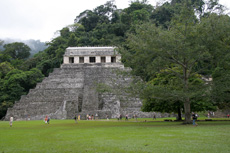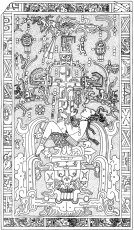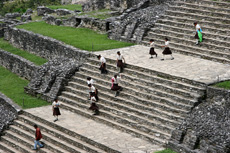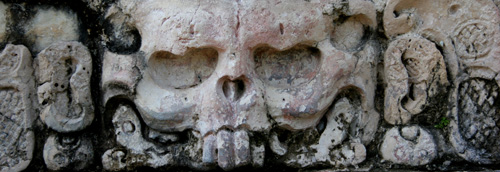 |
|
Pakal |
Palenque rises out of a sea of green. A brief history, focusing on Pakal. Theories on collapse. (Map this!)
 |
|
Temple of Inscriptions |
Our introduction to the ancient Maya was the site of Palenque, majestically set in the green jungles of Chiapas. Strategically located in the foothills over looking the green fields of the Yucatan peninsula, Palenque rose to prominence around 500 A.D. The ruler most responsible for what we see at the site today was K’inich Janaab’ Pakal, who was dubbed “The Mayan Astronaut” by Erich von Däniken in his infamous book “Chariots of the Gods?”
 |
|
Astronaut? |
Scholars call the greatest florescence of the Maya the ‘Classic Period’, which lasted from about 100 B.C. to 900 A.D. The early part of this period was dominated by the great Mayan center of Tikal which controlled the trade with Teotihuacan in the central valley of Mexico. In a severe turn of events Teotihuacan declined around 535 A.D and the fall almost caused the Tikal to collapse. But the Maya recovered from this “Middle Classic Hiatus” and went on to reach even higher peaks. In the power vacuum of the hiatus rose four power centers where previously Tikal had dominated the landscape. Palenque was one of those centers.
The building that dominates the central plaza is the well proportioned Temple of Inscriptions. In 1952 archaeologist Alberto Ruz cleared a passage deep into the edifice and the tomb of Pakal the Great was revealed to the world. Arrayed in fine jade ornaments Pakal was laid to rest in an ornate sarcophagus. To von Däniken the carving on the lid depicted Pakal piloting a space ship. Scholarly interpretations are less fantastical – Pakal being accepted into the Mayan underworld or Xibalba with the sky guardian looking on.
 |
|
Steep stairs |
In the morning Palenque was misty and cool, with calls of howler monkeys echoing through the site. A Keel-Billed Toucan (yes, the cereal box bird) flew past and put forth his grating call from a nearby tree. In looking at the splendor of the buildings and the monumental task of clearing and grading such a large surface, I immediately began to wonder why such a civilization would collapse after a millennium of successful accomplishment in art, architecture, and agriculture. The most popular theory quoted by the guides is that of ecological destruction – they destroyed their environment as we are doing today and hence faded into history…
 |
 |
 |
 |
|
Temple |
Palace |
Neena |
Lizard |
The theory of ecological disaster seems a little simplistic to me – how can a people who successfully exploited the environment they were in for a thousand years all of a sudden become incapable of it? Many scholars today believe the fall may have been a combination factors – ecological destruction, loss of confidence in the rulers, invaders from outside, etc. Maybe it was a perfect storm like a war in Iraq, sub-prime lending, and a collapsing housing market?
 |
Lets see:
1. Ecological destructions – check
2. Loss of confidence in leaders – check
3. Eternal war – check
4. Collapse of financial markets – check
Maybe George W. Bush is a student of [Mayan] History after all!
Oh, God! Fed, it was so obvious I didn’t see history repeating itself.
Joseph Tainter argues that the collapse of civilizations are caused by increased complexity. As the empire grows it requires higher and higher degrees of specialization, which in turn puts more demand on resources. Eventually some critical resource runs out and the civilization comes to an end.
So, according to him it is the complexity that is the root cause of the problem, not the lack of resources, which is just an apparent problem.
Shreesh,
Do you subscribe to Tainter’s theory? It seems like the modern world has a level of specialization far beyond anything in antiquity! One thinks of individuals whose sole job is to be a “market maker” for a particular stock on Wall Street – or someone who is paid to write computer programs for a particular industry in a specific language – like the guy who does testing for Microsoft Word for Simplified Chinese. Thats pretty specialized, no? Are we doomed?
Fred –
Tainter does have some interesting theories and I do believe he is correct to a large extent. The reason why we can support such specialization is that farmers like George Naylor, mentioned in the “Omnivore’s Dilemma”, grow enough food for 129 people.
Tainter’s theory is that specialization will continue until there are no longer enough George Naylor’s to support all the specialists. At that point our civilization will collapse. But the collapse will actully be “good” in the sense that most people will be better off – the plumbers, electricians, farmers, barbers, and even computer scientists will be given their proper due. The hedge fund managers will have a tough go of it.